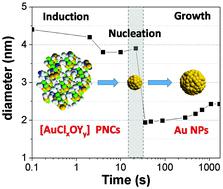Our official English website, www.x-mol.net, welcomes your
feedback! (Note: you will need to create a separate account there.)
The role of pre-nucleation clusters in the crystallization of gold nanoparticles.
Nanoscale ( IF 5.8 ) Pub Date : 2020-07-08 , DOI: 10.1039/d0nr03486j Raj Kumar Ramamoorthy 1 , Ezgi Yildirim 2 , Enguerrand Barba 2 , Pierre Roblin 3 , Jorge A Vargas 4 , Lise-Marie Lacroix 2 , Isaac Rodriguez-Ruiz 3 , Philippe Decorse 5 , Valeri Petkov 6 , Sébastien Teychené 3 , Guillaume Viau 2
Nanoscale ( IF 5.8 ) Pub Date : 2020-07-08 , DOI: 10.1039/d0nr03486j Raj Kumar Ramamoorthy 1 , Ezgi Yildirim 2 , Enguerrand Barba 2 , Pierre Roblin 3 , Jorge A Vargas 4 , Lise-Marie Lacroix 2 , Isaac Rodriguez-Ruiz 3 , Philippe Decorse 5 , Valeri Petkov 6 , Sébastien Teychené 3 , Guillaume Viau 2
Affiliation

|
The syntheses of metal nanoparticles by reduction in apolar solvents in the presence of long chain surfactants have proven to be extremely effective in the control of the particle size and shape. Nevertheless, the elucidation of the nucleation/growth mechanism is not straightforward because of the multiple roles played by surfactants. The nucleation stage, in particular, is very difficult to describe precisely and requires in situ and time-resolved techniques. Here, relying on in situ small angle X-ray scattering (SAXS), X-ray absorption spectroscopy (XAS) and high-energy X-ray diffraction (HE-XRD), we propose that ultra-small gold particles prepared by reduction of gold chloride in a solution of oleylamine (OY) in hexane with triisopropylsilane do not follow a classical nucleation process but result from pre-nucleation clusters (PNCs). These PNCs contain Au(III) and Au(I) precursors; they are almost stable in size during the induction stage, as shown by SAXS, prior to undergoing a very fast shrinkage during the nucleation stage. The gold speciation as a function of time deduced from the XAS spectra has been analyzed through multi-step reaction pathways comprising both highly reactive species, involved in the nucleation and growth stages, and poorly reactive species acting as a reservoir for the reactive species. The duration of the induction period is related to the reactivity of the gold precursors, which is tuned by the coordination of OY to the gold complexes, while the nucleation stage was found to depend on the size and reactivity of the PNCs. The role of the PNCs in determining the final particle size and structure is also discussed in relation to previous studies. The multiple roles of OY, as the solubilizing agent of the gold salt, the ligand of the gold complexes determining both the size of the PNCs and the reactivity of the gold precursors, and finally the capping agent of the final gold particles as oleylammonium chloride, have been clearly established. This work opens new perspectives to synthesize metal NPs via metal–organic PNCs and to define new synthesis routes for nanoparticles that may present structure and morphologies different from those obtained by the classical nucleation routes.
中文翻译:

预成核簇在金纳米颗粒结晶中的作用。
在长链表面活性剂的存在下,通过在非极性溶剂中还原来合成金属纳米颗粒已被证明在控制粒径和形状方面极为有效。然而,由于表面活性剂起着多种作用,因此对成核/生长机理的阐明并不简单。尤其是,成核阶段很难准确描述,需要原位和时间分辨技术。在这里,就地依赖小角度X射线散射(SAXS),X射线吸收光谱(XAS)和高能X射线衍射(HE-XRD),我们建议通过在氯化钠溶液中还原氯化金制备超细金颗粒具有三异丙基硅烷的己烷中的油胺(OY)不遵循经典的成核过程,而是由预成核簇(PNC)产生的。这些PNC包含Au(III)和Au(I)前体;如SAXS所示,它们在成核阶段的尺寸几乎稳定,然后在成核阶段迅速收缩。已通过多步反应途径分析了从XAS光谱推断出的金形态随时间的变化情况,该途径包括参与成核和生长阶段的高反应性物种和充当反应性物种储集层的低反应性物种。诱导期的持续时间与金前体的反应性有关,这是通过OY与金络合物的配合来调节的,而成核阶段则取决于PNC的大小和反应性。还与先前的研究讨论了PNC在确定最终粒径和结构中的作用。OY的多重角色,作为金盐的增溶剂,已经清楚地确定了决定PNC尺寸和金前体反应性的金配合物配体,最后确定了最终金颗粒作为氯化铝铵的封端剂。这项工作为合成金属纳米颗粒开辟了新的前景。通过金属有机PNC并为纳米粒子定义新的合成路线,这些合成路线可能呈现出不同于经典成核途径的结构和形态。
更新日期:2020-08-06
中文翻译:

预成核簇在金纳米颗粒结晶中的作用。
在长链表面活性剂的存在下,通过在非极性溶剂中还原来合成金属纳米颗粒已被证明在控制粒径和形状方面极为有效。然而,由于表面活性剂起着多种作用,因此对成核/生长机理的阐明并不简单。尤其是,成核阶段很难准确描述,需要原位和时间分辨技术。在这里,就地依赖小角度X射线散射(SAXS),X射线吸收光谱(XAS)和高能X射线衍射(HE-XRD),我们建议通过在氯化钠溶液中还原氯化金制备超细金颗粒具有三异丙基硅烷的己烷中的油胺(OY)不遵循经典的成核过程,而是由预成核簇(PNC)产生的。这些PNC包含Au(III)和Au(I)前体;如SAXS所示,它们在成核阶段的尺寸几乎稳定,然后在成核阶段迅速收缩。已通过多步反应途径分析了从XAS光谱推断出的金形态随时间的变化情况,该途径包括参与成核和生长阶段的高反应性物种和充当反应性物种储集层的低反应性物种。诱导期的持续时间与金前体的反应性有关,这是通过OY与金络合物的配合来调节的,而成核阶段则取决于PNC的大小和反应性。还与先前的研究讨论了PNC在确定最终粒径和结构中的作用。OY的多重角色,作为金盐的增溶剂,已经清楚地确定了决定PNC尺寸和金前体反应性的金配合物配体,最后确定了最终金颗粒作为氯化铝铵的封端剂。这项工作为合成金属纳米颗粒开辟了新的前景。通过金属有机PNC并为纳米粒子定义新的合成路线,这些合成路线可能呈现出不同于经典成核途径的结构和形态。









































 京公网安备 11010802027423号
京公网安备 11010802027423号